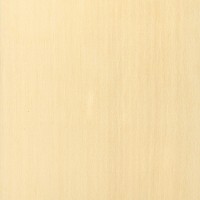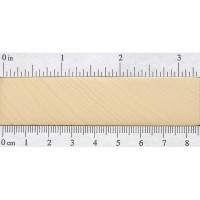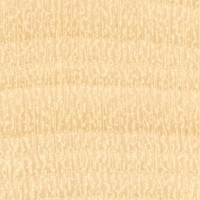 |
Common Name(s): Holly, American Holly Scientific Name: Ilex opaca Distribution: Eastern United States Tree Size: 30-50 ft (9-15 m) tall, 1-2 ft (.3-.6 m) trunk diameter Average Dried Weight: 40 lbs/ft3 (640 kg/m3) Specific Gravity (Basic, 12% MC): .50, .64 Janka Hardness: 1,020 lbf (4,540 N) Modulus of Rupture: 10,300 lbf/in2 (71.0 MPa) Elastic Modulus: 1,110,000 lbf/in2 (7.66 GPa) Crushing Strength: 5,540 lbf/in2 (38.2 MPa) Shrinkage: Radial: 4.8%, Tangential: 9.9%, Volumetric: 16.9%, T/R Ratio: 2.1 |
Color/Appearance: Ideal lumber has a very uniform, pale white color with virtually no visible grain pattern. Knots are common, which can reduce the usable area of the wood. Can develop a bluish/gray fungal stain if not dried rapidly after cutting. Holly is usually cut during the winter and kiln dried shortly thereafter to preserve the white color of the wood.
Grain/Texture: Grain is interlocked and irregular. Medium to fine uniform texture with moderate natural luster.
Endgrain: Diffuse-porous or semi-ring-porous; small to medium pores predominantly in radial multiples of 2-4, commonly arranged in radial rows, moderately numerous to numerous; growth rings may be distinct due to an intermittent row of earlywood pores; rays in variable sizes from narrow to very wide, normal to close spacing; parenchyma not typically visible with lens.
Rot Resistance: Rated as non-durable or perishable, and susceptible to insect attack.
Workability: Can be difficult to work on account of the numerous knots and interlocked grain. Glues, stains, and finishes well, and is sometimes stained black as a substitute for Ebony. Turns well on the lathe.
Odor: No characteristic odor.
Allergies/Toxicity: Besides the standard health risks associated with any type of wood dust, no further health reactions have been associated with Holly. See the articles Wood Allergies and Toxicity and Wood Dust Safety for more information.
Pricing/Availability: Seldom available for commercial sale, Holly is an expensive domestic lumber, and is usually only available in small quantities and sizes.
Sustainability: This wood species is not listed in the CITES Appendices or on the IUCN Red List of Threatened Species.
Common Uses: Inlays, furniture, piano keys (dyed black), broom and brush handles, turned objects, and other small novelty items.
Comments: Holly is typically used only for ornamental and decorative purposes. It has a fairly large shrinkage rate, with a lot of seasonal movement in service, and its strength properties are mediocre for a hardwood.
Scans/Pictures: As you can see from the pictures below, unlike other light-colored woods, Holly remains light-colored even after a finish has been applied, (assuming a non-yellowing finish was used.)





Have 6 10’ logs from 3 trees cut yesterday. The 3 butt logs are about 12” in diameter. I am sitting here contemplating how to saw them. Everything will go straight into a small dehumidifying dryer. I am going to try to get a 2” board out of each butt for turning stock. Other than that various thicknesses down to 4/4. I am curious to see how knotty it is.
Are the straight staves or twisted. Holly tends to split and twist when drying…notoriously famouse for that when not seasoned. If well seasoned holly is a treasure, if the staves are straight then you can try making a selfbow, will work well.
Has anyone tried staining holly? I have about 10 pieces 10″ wide, 5 ft long and 1 1/2″ thick.
I can’t get any finish to look nice as is.
According to this article, it stains and finishes well. I can’t imagine that an almost perfectly white wood with low rot resistance could pose very much of a problem for staining. But I’ve never worked with it, so I can’t say from experience.
Also, if it doesn’t look nice as it is, you could pair it with a darker wood for a contrasting appearance.
I cut and milled a holly tree then dried it in a solar kiln. The grain has a bluish-green appearance. Is this going to be safe to use for a cutting board?
The Holly tree is regarded in Pagan culture to be extremely important indeed, I believe this tree was/is used in religious practices- certainly during the winter solstice period. The bark is very resinous and burns with an antiseptic, pine like odour and smokes almost candle like.
Deepseek returns a comprehensive breakdown of the chemistry of this interesting tree, not least containing terpenes- pinene, limonene and myrcene. Phenolic compounds- antioxidants and bioactive compounds- antifungal, antiviral and potentially anti-cancer. Quite a spectacular species!
I made this serving board for my inlaws out of Osage orange, holly, and Verawood. I was really worried about losing the white of the holly, so i finished it separately by sealing in water poly. Then I glued the 3 color stripes together and coated everything in oil poly. The oil poly ambered a little of course, but it isn’t as bad as if i had just gone with straight oil poly. I also made a matching bottle opener.
i got some with pink to reddish purple spalting… no clue why
I had the good fortune to cut a dying American holly tree that was over 20″ across. Game call makers refer to it as “poor man’s ivory”. Using black permanent ink on the wood gives almost a scrimshaw appearance. I have been able to cut some of the holly I harvested with a quarter sawn orientation. These pieces are very desirable for my use.
I am working on this, a shooting block with vice inlaying using holly for the white stripes and bloodwood for the red..blue Mahoe for the blue background for the stars which will also be holly..
Attempting to air dry a 70 year old tree. That I just slabed out in 10 foot sections 1 1/4 thick. Some of the boards are a foot wide. Fingers crossed.
How is it working out for you? I just cut, stacked and strapped about 40’. 3.5’ pieces over 1” thick. It’s going to the kiln in a week.
I have managed to reduce the moisture contact down below 10% by only air drying. I am also pleased there was minimal checking and zero staining from mold growth. So far so good.
Hows the feel of ruff lumber compared to ash.
It’s wayyy smoother. Similar to how Yew wood feels
I have what I think is Japanese holly. A rather large shrub in my yard died and remained there, dead, for 2 years. When cutting it I noticed that the wood was similar in color and hardness to mahogany (but more reddish). Milled a few 8” long 2 x3’s. Quite beautiful. Anyone familiar with this shrub?
Sounds more like Manzanita
Sammy, that sounds about right. However, if I run a thumb-nail into the face grain, it ever-so-slightly imprints the surface, much like African Mahogany would.
Manzanita’s Janka rating is above 2300. Would such a hard surface yield a thumb nick?
Just an update: Turns out the shrub is called Japanese Cleyera. As I said, it’s very dense and beautiful wood. I have recently used it in handplane making. Time will tell, tell, though, if it holds up.
Curious how you are milling such small diameter wood?
By properly holding a piece at both ends, can mill on the bandsaw. Or, clamp a straight guide and use a skilsaw or sawzall, or even a sharp bowsaw.
I have an object in Holly that’s turned more yellow. Is there a way to return it to white? I’m taking no but it doesn’t hurt to ask
Probably not without stripping off the finish and then refinishing.
How should I “cure or store” my holly? I just cut down a 50’ tree with a 1.5’ diameter trunk. Want to know how beat to store it for carving and use later
Seems like it would be tough to properly dry a large chunk as those used for carving without getting some sort of fungal staining. Ideally, you’d want to slice the trunk up into boards as soon as possible and get the wood dried quickly to prevent discoloration.
How would one do this in a traditional way? Should I remove the bark, ie skin it? And store it elevated outside? Store inside? I cut it into 10’ sections and have 4 of them. I was planning on carving totem poles with them.
Without major equipment, how would one take care of this situation?
In my limited experience with this wood I’ve found it cracks a lot while drying. I had a 10″ diameter trunk and the pieces I kept with the bark intact dried much better than the pieces I cut green.
In my experience, there is no better wood for relief carving. It takes and holds crisp detail, and the absence of pronounced grain means no distraction from the carved contours.
Although multiple boards will need to be joined for even moderately sized panels, the uniformity of color means the joints will be virtually invisible.
I recently finished a sculpture that I made from snow white holly. It’s an absolute pleasure to work with! The pieces I purchased were so white you couldn’t tell the endgrain from the side grain, crazy! Carves and sands especially well and can achieve a natual luster at around 600 grit. Such a wonderful wood.
That is Beautiful! Is it all one piece of wood? Forgive my ignorance for not knowing. I worked on an old 1867 two masted double ended Ketch that we put an Ipe deck on with holly buttons over the screws. It came out great. Though I hear the Ipe has started to feather. Ugh. But the dark wood with the holly wood buttons, looked beautiful. As is your sculpted piece. What size is it? It is great! Shirley
known as “the whitest ” of all woods , it pretty much holds true to that title , holly comes in several variations …., youpon , big leaf ect.. , I have used both big leaf and youpon holly with great results , although youpon holly rarely exceeds 12″ in diameter at the base , mostly a shrub , but for inlays and small projects it works great.
I had an allergic reaction to this wood. Always remember to test sand woods. (So much sneezing!)
I see the sap and leaves are reported else where to cause skin irritation. No concerns about that with the dried wood?
I’m wondering how much it shrinks in length. Considering using some for columns. Most wood doesn’t shrink much at all in length.
I agree, great website.
Very interesting to note above that cured holly is easier to work, Green Holly leaves an awful gunk on my band saw blade. Does cured Holly do the same?
BTW: This site is awesome! Thanks so much for participating.
I’ve only used dry holly but I had no issues with shrinking or movement once it was glued in place. It’s expensive and hard to come by but if you get the good stuff it’s really ultra white. The description says it’s more of a satin finish but I haven’t had the experience with Tung oil. Sanded to 2000 or higher and it has a beautiful a lustrous glow to it. If you can get it then you should. Fabulous wood and easy to work with. The stripe in the middle of the legs is Holly with only one coat… Read more »
Holly is another one of my favorites. Fine grain is great for holding details and sharp edges.
Is the volumetric shrinkage percent of 16.9% correct? As related to radial of 4.8% and tangential of 9.9%, this seems high.
The only explanation that I can think of is that there are different samples and a different quantity of samples being used for each test. For instance, there may only be a few specialized samples cut to specifically measure the tangential and radial shrinkage (which require that it be cut with the grain lines at a very specific orientation), so there may be a smaller sampling for these numbers, whereas for the volumetric shrinkage, there may be a greater number of samples used as it is a more generic measurement of the whole volume of wood regardless of its size… Read more »
It doesn’t seem high, it seems low.
4.8% radial and 9.9% tangential shrinkage means a cylinder 10 cm wide and 10 cm tall will be have a volume of 785.4 cm^2 before shrinking, and 641.3 cm^2 after shrinking. That’s an 18.3% volume reduction.
That said, holly is always sold as dried wood, both because of the shrinkage, but also because it’s one of very few woods that’s tougher to work when green. So unless you harvest your own holly, it should not be much of a problem. Just seal it well after forming.